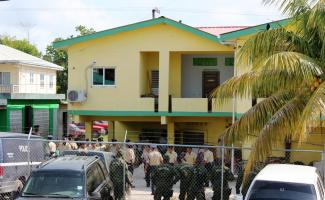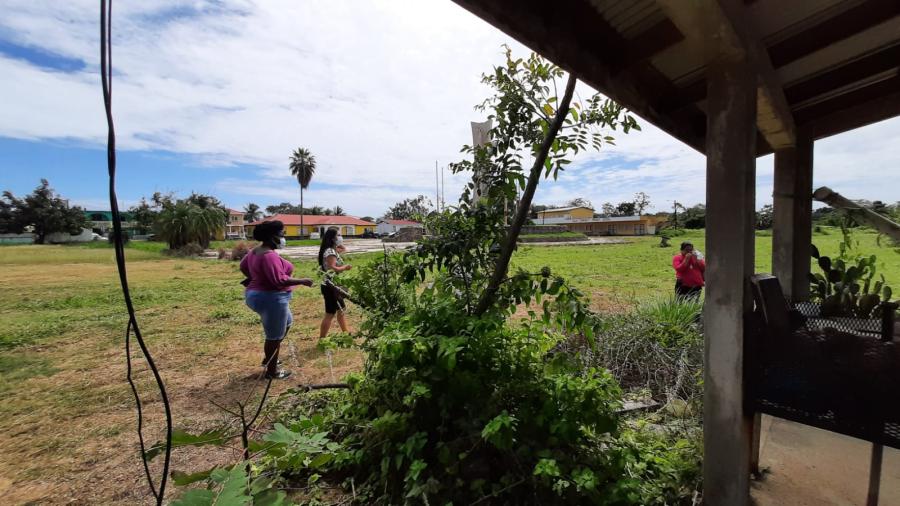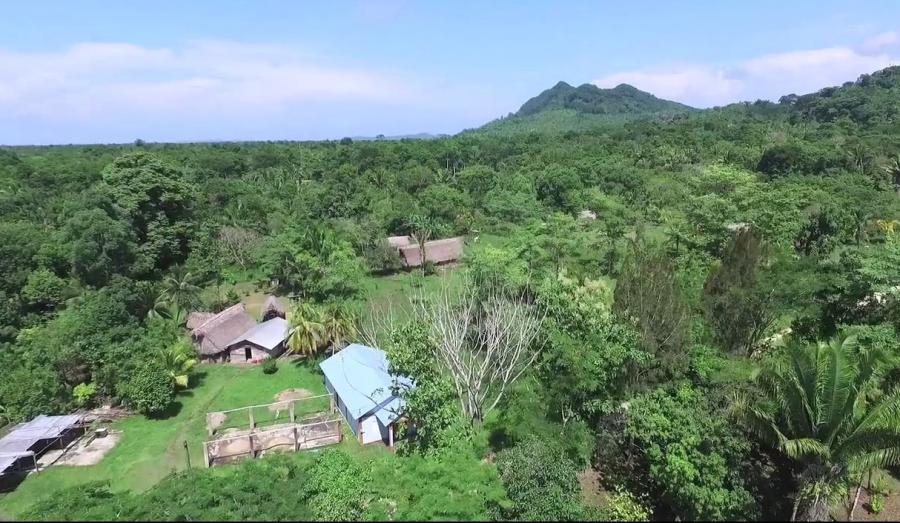
On the outskirts of Santa Cruz village in the Toledo district of Belize stands a small shack on top of a lush green hill. The structure itself is unassuming, barely visible from the southern highway below. Thick forest partially obscures it from view and adds to its perceived insignificance. The average passerby would not think twice about this tiny house, but to the villagers of Santa Cruz it towers like a skyscraper, casting an ominous shadow over their community.
The structure is the home of Rupert Myles, a Belizean man who unlawfully constructed it on communal Maya land. His actions resulted in turmoil that hit a boiling point in June 2015 when Maya leaders detained him following a contentious village meeting; Myles’ detention led to the government prosecution of 13 Maya villagers for alleged aggravated assault. On the surface, this situation appears to be an isolated incident that arose from miscommunication and a legal gray area—a man mistakenly occupied land he didn’t own a title to—but it is intimately related to the Mayas’ decades-long struggle for their rights as Indigenous Peoples in Belize, rights intrinsically tied to the protection and enjoyment of their lands.
The Maya are the traditional inhabitants of the land that now comprises parts of Mexico, Guatemala, and Belize. However, centuries of colonization and subsequent subjugation have pushed them to the margins of society. Their languages, cultures, traditions, and livelihoods are increasingly jeopardized. Over the past 2 decades, the 39 Mayan communities across southern Belize have coordinated to stand up for their traditional communal lands and legal systems to be recognized by the Government of Belize. Cristina Coc, a Maya leader and mother of two, defender of Maya rights and their lands, explained, “Perhaps one of the things that is seldom understood is that we are the stewards of our natural world.”
Coc and her people fight for equality under the law and for protection of their customary lands and culture from outside interference. Such interference not only affects the Mayas’ legal rights, but also their daily lives. It imperils the farming land they use for subsistence and pollutes the streams from which they drink. And now, with assault charges against them, mothers and fathers are at risk of being torn away from families that depend on them for survival.
Maya Leaders Alliance
The Toledo Alcaldes Association, a collection of traditionally elected leaders from each village, and the Maya Leaders Alliance (MLA), which provides the alcaldes with technical support, have spearheaded a campaign for the full recognition of the Maya as Indigenous Peoples of Belize. Their efforts have brought them to the Supreme Court of Belize twice, once in 2007 and again in 2010 after the government of Belize appealed a ruling that granted the Maya legal rights to their lands. In both cases it was affirmed that under Belizean law, Toledo Mayan communities hold title to the lands they have traditionally lived on and stewarded.
These pertinent rulings should have set in motion a reversal of the government’s appropriations of lands within Maya territories. Instead, in 2010, despite the Supreme Court rulings, the government of Belize extended Texas-based oil company US Capital Energy’s concession to begin a second phase of oil exploration, which had begun in 2001. This has been carried out inside the Sarstoon-Temash national park on ancestral Maya lands and without their Free, Prior and Informed Consent. Since then the corporation has cut over 200 miles of exploratory seismic trails. This has caused forest fires that have destroyed 400 acres of forest on traditional Mayan land in southern Belize, and has privatized and restricted access of the Maya people to their forests.
This is especially problematic due to Belize’s responsibilities under international law. Belize endorsed the UN Declaration on the Rights of Indigenous Peoples and received recommendations from the Inter-American Commission on Human Rights to cease extraction operations. Officially, at least as far as appearances, the government has guaranteed the Maya the right to Free, Prior and Informed Consent. But the government blatantly disregarded these obligations in its dealings with US Capital Energy and failed to implement the Supreme Court’s decisions in the process. The government of Belize pledged to protect its Indigenous Peoples, but in reality it further marginalized and endangered their lands, lives, and customs.
At best, this is negligent incompetence by the government of Belize, and at worst it is a deliberate disregard for international law and the well-being of its citizens. Regardless, the government’s inconsistency led the Maya Leaders Alliance and the Toledo Alcaldes Association to take their case to the Caribbean Court of Justice in 2015. In April 2016, the court reaffirmed that the 39 Indigenous communities of southern Belize had rights to the land they have customarily used and occupied. This decision held extra significance because the Caribbean Court of Justice is Belize’s highest appellate court, and its ruling convinced the government to finally agree that Maya title to communal lands exists. The judgment awarded damages for previous destruction of land and development projects that took place without Free, Prior and Informed Consent. It also required the government of Belize to demarcate and register Maya villages and lands and to protect these lands from any further interference. The court decided to supervise and implement this process, obliging all parties involved to report on their progress in 2016.
Implementing the Legal Precedent
At the time, Maya leader and President of the Toledo Alcaldes Association, Alfonso Cal, said, “We have been dragged through the courts for over 30 years, but today we are happy that the highest court again stood with my people to ensure that Belize gets on the right side of history.” This sentiment prevailed amongst Indigenous rights defenders worldwide. Many felt that the Caribbean Court of Justice victory set a new precedent in international law relating to Indigenous rights, demonstrating an example in which an international body could hold a sovereign government accountable for its actions toward Indigenous Peoples.
Unfortunately, much work remains for this accountability to be realized in southern Belize. The government has failed to even begin registering Maya lands. It has not followed its mandate to recognize Maya land tenure and has not stopped outside agitators from interfering on these communal lands. Professor James Anaya, Indigenous legal scholar and former UN Special Rapporteur on the Rights of Indigenous Peoples, interpreted the judgement: “Both the Caribbean Court of Justice and the Inter-American Commission have directed that, not just must the government itself, through its various agencies, act consistently with Maya property rights, but it must also act affirmatively to protect those rights from private parties who might adversely affect Maya property or intrude upon Maya customary lands. Furthermore, as the order of the Caribbean court makes clear, the government must act to protect Maya customary lands from intruders now, even before those lands are officially registered, not at some time in the indefinite future.” Belize’s failure to do exactly that is what allowed the current situation with Rupert Myles to unfold in the village of Santa Cruz.
Myles, who is not Maya, began constructing a house on the protected archaeological site of Uxbenka, located in Santa Cruz. Uxbenka is also a historically sacred site for the Maya, lying within their ancestral lands. He did not apply for residence, which is required under Maya customary law. These transgressions alone should have stirred the government of Belize into action based on its Caribbean Court of Justice commitments, but instead it remained passive.
When the Maya community of Santa Cruz village first became aware of Myles’ unlawful construction on their sacred site, they were stymied by bureaucracy. Manuel Pop, the first alcalde, sent Myles several eviction notices. He later contacted the Punta Gorda police to report Myles’ lack of cooperation, with no response. Myles also failed to attend the fajina, a customary community meeting that all members of the village are required to attend. Any villager who misses this meeting is required to pay a tax for his or her absence. While living in the village, the only fajina Myles attended was on the fateful day that he showed up unannounced and belligerent.
Myles’ stay in the village was far from subtle. Pop recounts that he liked to shoot his gun into the sky during the night. “Some of the villagers would tell me that they heard as many as 12 gunshots throughout the night and they would get scared because it happened several times,” Pop says. Myles also took the liberty of bulldozing the land to create a driveway, causing irreparable damage to Uxbenka. Following these incidents, the alcaldes decided to send Myles a final eviction notice, stating that his house would be forcibly dismantled if he did not move.
On June 20, 2015, Myles showed up to a fajina clearly enraged with the notice. He interrupted the process and insisted on dealing with his issue first. He was told to take a seat and wait until the other open discussions were finished. While the Maya resumed their meeting, speaking in Mopan, Myles became convinced that they were speaking about him and grew aggressive. He threatened several villagers and said that he would return with his gun.
At this point the alcalde decided that it was in the best interest of the villagers to detain him. The village police struggled to control him and some of the villagers had to assist in handcuffing him. They then took him to his house, where his father-in-law pleaded for two more weeks to ensure the structure was taken down. A volunteer attorney drafted an agreement, which was signed by Myles’ father-in-law, along with Myles, his wife, the alcaldes, and the village chairman. The villagers’ sense of relief following the cease and desist agreement was short lived. Following the events of June 20, Myles reported the incident to the Punta Gorda police, complete with accusations of assault and racial discrimination. The Punta Gorda police took action by arresting 13 Santa Cruz villagers for unlawful arrest and assault.
It was 4:00 in the morning when the police burst into homes in Santa Cruz village on June 24, their brute force injuring several and terrifying many more. Villagers were disrupted from their sleep with flashlights, had rifles pointed at them, and were treated like criminals. Two members of the “Santa Cruz 13” were pardoned on March 30, 2016 due to insufficient evidence. One of these villagers, Raymundo Sho, reported that his wife and his son were injured during the arrests. Timoteo Sho, Sho’s son, was verbally abused and hit in the head with the butt of a rifle. Another officer pushed Sho’s wife to the ground and stepped on her shoulder, spraining it. When she attempted to report her injury to the police she was not allowed to do so, nor did she receive any treatment for her sprain; instead she was forced to create a makeshift sling and wait until it healed. This excessive use of force was not only disproportionate to the alleged crime, it was also disrespectful towards the Maya customary process of confronting the village alcalde before taking any sort of action in the village.
In addition to the 12 villagers arrested in Santa Cruz, the police separately arrested Coc for the same charges. Coc has served as spokesperson for the Maya Leaders Alliance for the last decade. She has been a central voice and key figure in the fight to protect Maya lands, and is well respected among the Maya community. Having no role in the physical detainment of Myles, the charges against her demonstrate Belize’s overt discrimination and propensity to criminalize Indigenous leaders. Her crime is not assault; rather, she is guilty of being an outspoken advocate for the rights of her people and their lands.
Regardless of whether the charges result in a conviction, Coc and the 12 others have endured a year of their lives with criminal charges hanging over their heads. She, like many others before her and many Indigenous human rights and environmental defenders around the world today, is being criminalized for leading the fight for rights that the government is bound by international law to respect and protect. The government of Belize continues to fail her and harm the Indigenous Maya people by illegally conceding land to foreign companies and demonizing those who work to prevent this from happening.
Both incidents, the citizen’s arrest of Myles and the 4 a.m. police raid, have left villagers traumatized and tense. Several of the 13 villagers that have charges pending against them were not even involved in the peaceful detention of Myles. Basilio Teul, Sho, and Sho’s wife Oligario, are just a few of the victims that are claiming that they were mere bystanders during the incident. Marta Pop, one of three women who witnessed the citizen’s arrest, explained that the situation is “not good because I know it is not true. I saw what happened and they were not aggressive with Mr. Myles.” Meanwhile, Myles’ house still stands.
The case is one small example of the ongoing colonization of Indigenous land. Despite the victory that the Toledo Maya had won just two months earlier in the Caribbean Court of Justice, the highest court that Belize is responsible to, the autonomy of the Maya people still fails to be fully recognized and respected by the country’s authorities. Anaya, a long-time ally of the Maya people, framed the issue:
Belize stands at crossroad in its history and in defining the way forward in its treatment of the Maya people. This crossroad is marked by two distinct, historical trends that are present on a global scale. One is rooted in historical patterns of thinking and action that have discriminated against Indigenous Peoples and facilitated the taking of their lands by failing to recognize their customary land tenure and property systems that are crucial to their survival. Unfortunately, that trend can be seen in the positions and actions of government officials in many countries across the world. But in many countries and internationally, that trend is being taken over by a modern, more enlightened one; one that starts with the premise that Indigenous Peoples are equal in value and dignity to all others, and that is more and more accepting of the proposition that their own systems of property and land tenure are to be treated on the basis of equality. This modern trend understands that embracing these rights of Indigenous Peoples is a mark of a truly democratic state that is genuinely respectful of the human rights of all. The courts of Belize, the Caribbean Court of Justice, and the Inter-American Commission on Human Rights have together marked a path for Belize along the more enlightened, modern trend, by upholding the property rights established by the Maya people’s own laws and traditions on the same terms as the property rights of others. The government has made a commitment to follow that path. The world expects that it now make good on that commitment.
On May 11, 11 months after militarized police officers stormed the village of Santa Cruz and the homes of Santa Cruz villagers and arrested 13 leaders, the chief magistrate accepted a submission from the director of Public Prosecution for yet another adjournment—the seventh requested by the prosecution and the ninth overall, putting on hold the lives of the families of the accused who are left to bear the emotional and economic costs of a prolonged trial.
The Santa Cruz 13 have taken painstaking efforts to consistently present themselves at each trial date, while the complainant, Rupert Myles, has repeatedly failed to appear. The defense counsel has asked the court to exercise its authority under the law to dismiss the case because the prosecution is not ready. Instead, the court granted the adjournment until June 27, allowing the prosecutor time to acquire more evidence. The ongoing criminalization of Indigenous leaders denies them rights affirmed by the Caribbean Court of Justice. The Maya people continue to call upon the judicial system to ensure that the law is applied in a just and fair manner, and on the government of Belize to respect the rights of the Maya people of southern Belize and ensure that Indigenous rights defenders are protected.
International Standards of Indigenous Rights
Article 11 of the United Nations Declaration on the Rights of Indigenous Peoples states: Indigenous Peoples have the right to maintain, protect and develop the past, present and future manifestations of their cultures, such as archaeological and historical sites, artefacts, designs, ceremonies, technologies, and visual and performing arts and literature.
Article 20 states: Indigenous Peoples have the right to maintain and develop their political, economic and social systems or institutions, to be secure in the enjoyment of their own means of subsistence and development, and to engage freely in all their traditional and other economic activities.
Photo : A heavy police presence is felt at all court proceedings for the Santa Cruz 13. Photo by Kieron Farrelly.



